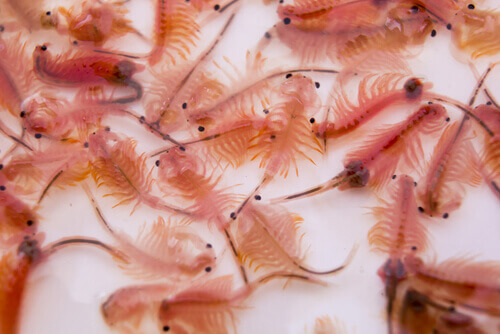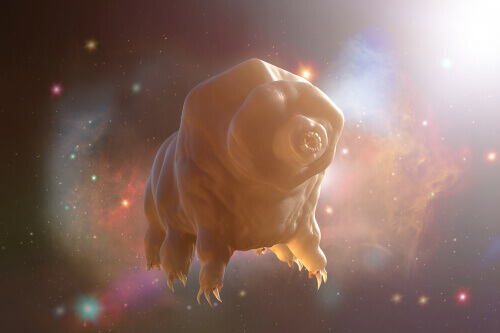The Fascinating Process of the State of Cryptobiosis


Written and verified by the biologist María Muñoz Navarro
Did you know there are animals capable of completely inactivating themselves during extreme situations? It’s true! Some living beings enter a state of latency or cryptobiosis during which they don’t carry out any type of metabolic activity. It allows them to survive extraordinary environmental conditions such as desiccation, lack of oxygen, low temperatures, lethal radiation, or a combination of all of them.
We invite you to continue reading about one of the most fascinating processes in nature.
Inactivation for survival through a state of cryptobiosis
Cryptobiosis is a process carried out by some organisms when faced with adverse conditions. In this state, they stop their metabolic activity to neither reproduce nor develop until conditions become favorable again. Thus, it’s a reversible phase that some like to refer to as “resurrection.”
Some animals go through this state in order to be able to remain alive for long periods of time. We’re talking about indefinite periods of time — infinite, theoretically.
Numerous invertebrate animals such as embryonic cysts of crustaceans, rotifers, nematodes, and tardigrades possess this ability, in addition to bacteria. Researchers have also observed it in some plant tissues, seeds, propagules, and even in more sophisticated plants.
According to what they’ve seen, it seems the state of cryptobiosis allows organisms to be on the brink of life, but also of death. This is why some scientists consider it the third form of biological organization.

The four types of animals who can inactivate themselves through a state of cryptobiosis
There are up to four types of cryptobiosis that depend on the extreme environmental situation that a given living being must endure:
Anhydrobiosis
This type of cryptobiosis occurs when a living being must endure long periods of desiccation and is characterized by the loss of water by evaporation. Through it, the animal loses more than 95% of their body fluids and suspend their metabolism.
Cryobiosis
An organism enters a state of cryobiosis when the temperature conditions are extremely low. This enables it to survive to freeze.
The cooling rate must be slow for this process to properly take place. The key to cryobiosis is freezing the living being, but avoiding the crystallization of liquids so as not to damage their internal tissues. Beings that experience cryobiosis can live for many years in this state.
Anoxybiosis
This state is induced when oxygen levels in the environment are low and even non-existent.
Osmobiosis
Animals that experience this type of cryptobiosis are those that face a wide variety of salt concentrations.
Examples of animals who can enter a state of cryptobiosis
Artemias salinas
When the circumstances aren’t optimal for the development and growth of the larvae of these small crustaceans, the eggs go into a state of inactivation for a long period of time. Furthermore, it can last up to 10 years.
Thus, they can withstand extreme situations such as the absence of water and oxygen, as well as temperatures below freezing. During these states of cryptobiosis, the eggs encyst and stop all metabolic processes until the conditions of water, oxygen, and temperature become favorable.

Rotifers can enter a state of cryptobiosis
Rotifers of the class Bdelloidea are microscopic invertebrates that inhabit freshwaters.
These organisms can enter a state of anhydrobiosis under desiccated conditions. This is why they adopt a formation called “tuns” when the water evaporates. They reduce their body volume through it. This is because they compact their organs and make the light disappear from their hollow organs.
Tardigrades
This is the most common cryptobiont organism.
Tardigrades, commonly known as water bears, are microscopic animals that inhabit both land, marine, and freshwater environments. The most surprising thing is they can enter all four types of cryptobiosis states:
- During anoxybiosis, they become immobile, transparent, and even rigid. Thus, they can remain up to 5 days in this state, except for strictly aquatic species that can only last a maximum of 3 days.
- As for the state of cryobiosis, it allows them to survive frozen for several years.
- Similarly, osmobiosis is an ability that allows freshwater tardigrades to contract when placed in a saline environment, while marine species become turgid in freshwater.
- Finally, these animals contract, retract the head and legs and adopt the immobile “tun” form (like rotifers) and enter a state of anhydrobiosis when they experience situations in which the amount of water that surrounds them decreases.
This is just how the tardigrades become highly resistant to extreme environmental conditions such as:
- Temperatures ranging from -273ºC to 150ºC
- High pressure
- The emptiness of space
- Radiation (both X-rays and UV)
- Chemical products

Conclusion
As you can see, cryptobiosis is a fascinating process that allows the survival of certain animals despite the unfavorable environmental factors. This ability allows them to colonize environments or situations that are unviable for other organisms.
It is, therefore, an advantage in the animal world and one more example of the amazing natural processes that’ll never cease to amaze us.
All cited sources were thoroughly reviewed by our team to ensure their quality, reliability, currency, and validity. The bibliography of this article was considered reliable and of academic or scientific accuracy.
- Nelson, D.R., Guidetti, R. and Rebecchi, L. Phylum Tardigrada. Thorp and Covich’s Freshwater Invertebrates: Ecology and General Biology: Fourth Edition. (2015).
- Clegg, J.S. Cryptobiosis: a peculiar state of biological organization. Comp Biochem. Physiol. B. Biochem. Mol. Biol. (2001) 128(4):613,624.
- Marotta, R., Lease, F., Ugetti, A., Ricci, C. and Melone, G. Dry and survive: morphological changes during anhydrobiosis in a bdelloid rotifer. J. Struct. Biol. (2010) 171(1):11-17.
- Martínez-Espinosa, R. Gambas y microalgas de las salinas como alimento de los fringílidos. Ornitología práctica (2015) 71: 54-57.
This text is provided for informational purposes only and does not replace consultation with a professional. If in doubt, consult your specialist.